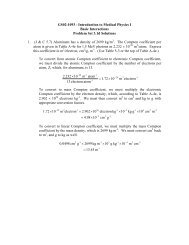link to lecture transcript - UT-H GSBS Medical Physics Class Site
link to lecture transcript - UT-H GSBS Medical Physics Class Site
link to lecture transcript - UT-H GSBS Medical Physics Class Site
You also want an ePaper? Increase the reach of your titles
YUMPU automatically turns print PDFs into web optimized ePapers that Google loves.
This figure is a plot taken from Johns & Cunningham. For each value of incident<br />
pho<strong>to</strong>n energy, we have a different curve for dσ/dE.<br />
Note first, that for each pho<strong>to</strong>n energy, there is a maximum energy of the Comp<strong>to</strong>n<br />
electron. What is this maximum electron energy? Recall that the maximum energy<br />
imparted <strong>to</strong> the Comp<strong>to</strong>n electron occurs when the pho<strong>to</strong>n is scattered 180°, or<br />
backscattered. We determined this quantity in the previous <strong>lecture</strong> <strong>to</strong> be equal <strong>to</strong> the<br />
energy of the incident pho<strong>to</strong>n multiplied by the ratio 2α divided by 1 + 2α. For<br />
example, for a 1 MeV pho<strong>to</strong>n, the energy of the scattered pho<strong>to</strong>n is 204 keV, so the<br />
maximum energy of the Comp<strong>to</strong>n electron is 796 keV. For a 500 keV pho<strong>to</strong>n, we<br />
can calculate the maximum electron energy <strong>to</strong> be a bit less than 350 keV.<br />
23





